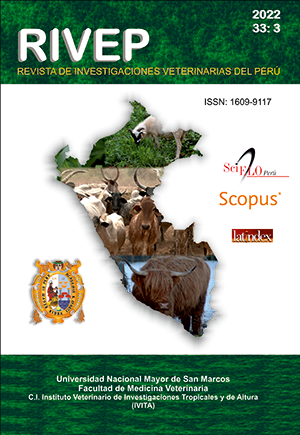Detection of extended-spectrum β-lactamase-producing Enterobacteriaceae (ESBL) isolated from retail chicken meat in a district of Lima, Peru
DOI:
https://doi.org/10.15381/rivep.v33i3.22899Keywords:
Enterobacteriaceae, genes, ESBL, PCR, CTX-M, TEMAbstract
The aim of this study was to determine extended spectrum β-lactam resistance genes (ESBL) from enterobacteria isolated in chicken meat samples obtained in markets in the Santiago de Surco district, Lima, Peru. In total, 34 samples were obtained for the microbiological procedure. Isolation was done using EMB and TSA agar. For the biochemical characterization of genus and species, the EnteroPluri-Test® Liofilchem kit was used. The antimicrobial susceptibility analysis was performed with the Kirby-Bauer method as screening and the Jarlier method for confirmation. Confirmed Enterobacteriaceae were evaluated by molecular diagnostics for extended spectrum β-lactam resistance genes. An end-point PCR was used for the amplification of CTX-M-1, CTX-M-2 and CTX-M-9 genes, and a duplex end-point PCR was used for the amplification of TEM and SHV genes. Results showed that 34 strains of enterobacteria were identified, with 20/34 suspected of producing ESBL enzymes under the Kirby-Bauer method, and 12/34 strains confirmed to produce ESBL under the Jarlier method. The enterobacteria were Salmonella choleraesuis (n=1), Escherichia coli (n=8), Serratia odorifera (n=1) and Klebsiella ozaenae (n=2). The identification of multidrug resistant strains (MDR) was 13/34, being E. coli (n=8), Klebsiella ozaenae (n=3), Serratia odorifera (n=1) and Salmonella choleraesuis (n=1). All (12/12) the phenotypically resistant strains for ESBL were positive for the detection of ESBL genes. The highest frequency corresponded to the CTX-M-1 gene (12/12), followed by the TEM gene (10/12) and the CTX-M-9 gene (2/12). No CTX-M-2 or SHV genes were detected. It is concluded that chicken meat sold by markets in the Santiago de Surco district contains enterobacteria (ESBL) with at least one resistance gene.
Downloads
Downloads
Published
Issue
Section
License
Copyright (c) 2022 Valeria Cortez-Sandoval, Rosa González, Daphne Ramos

This work is licensed under a Creative Commons Attribution 4.0 International License.
AUTHORS RETAIN THEIR RIGHTS:
a. Authors retain their trade mark rights and patent, and also on any process or procedure described in the article.
b. Authors retain their right to share, copy, distribute, perform and publicly communicate their article (eg, to place their article in an institutional repository or publish it in a book), with an acknowledgment of its initial publication in the Revista de Investigaciones Veterinarias del Perú (RIVEP).
c. Authors retain theirs right to make a subsequent publication of their work, to use the article or any part thereof (eg a compilation of his papers, lecture notes, thesis, or a book), always indicating the source of publication (the originator of the work, journal, volume, number and date).



